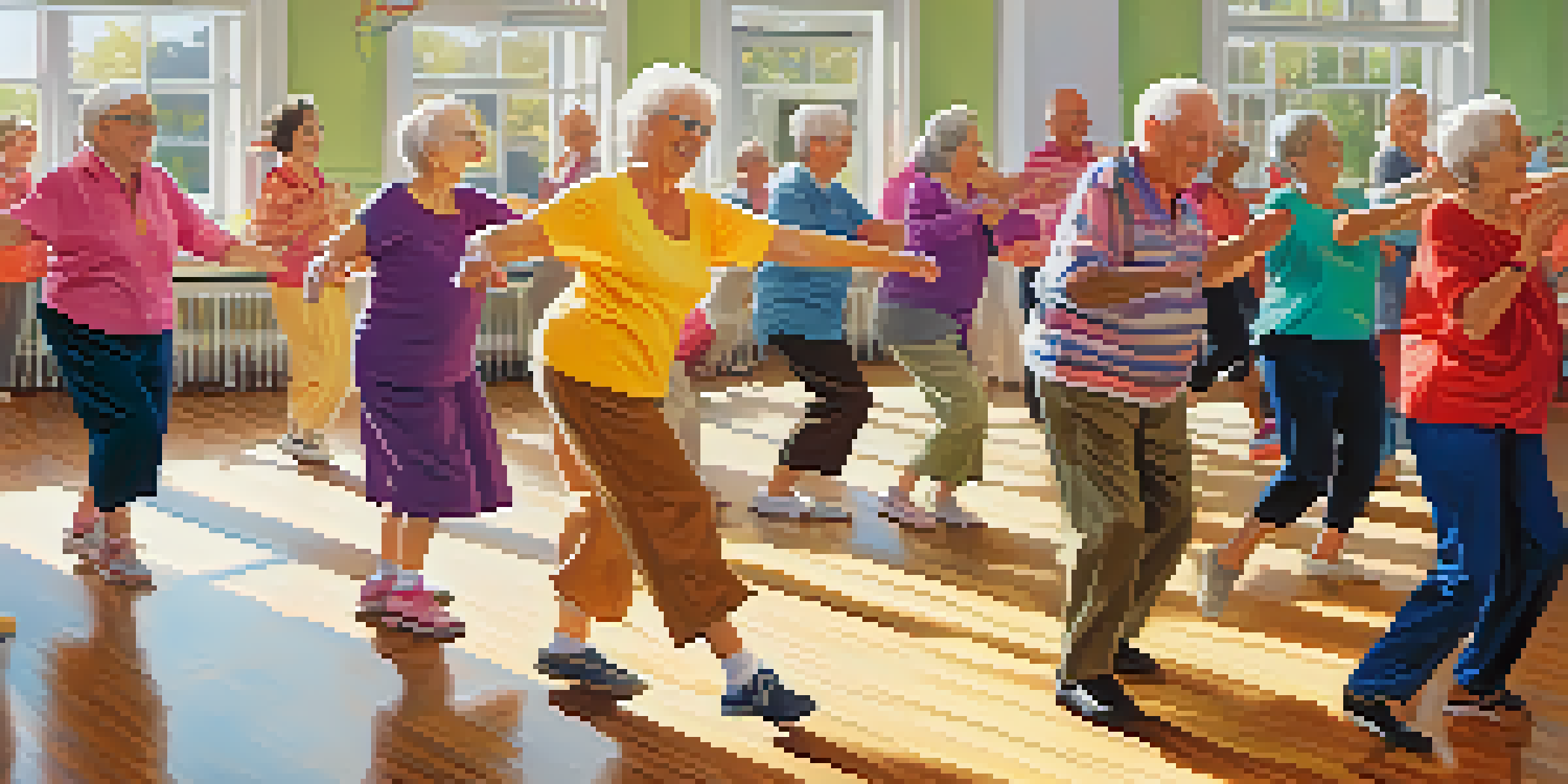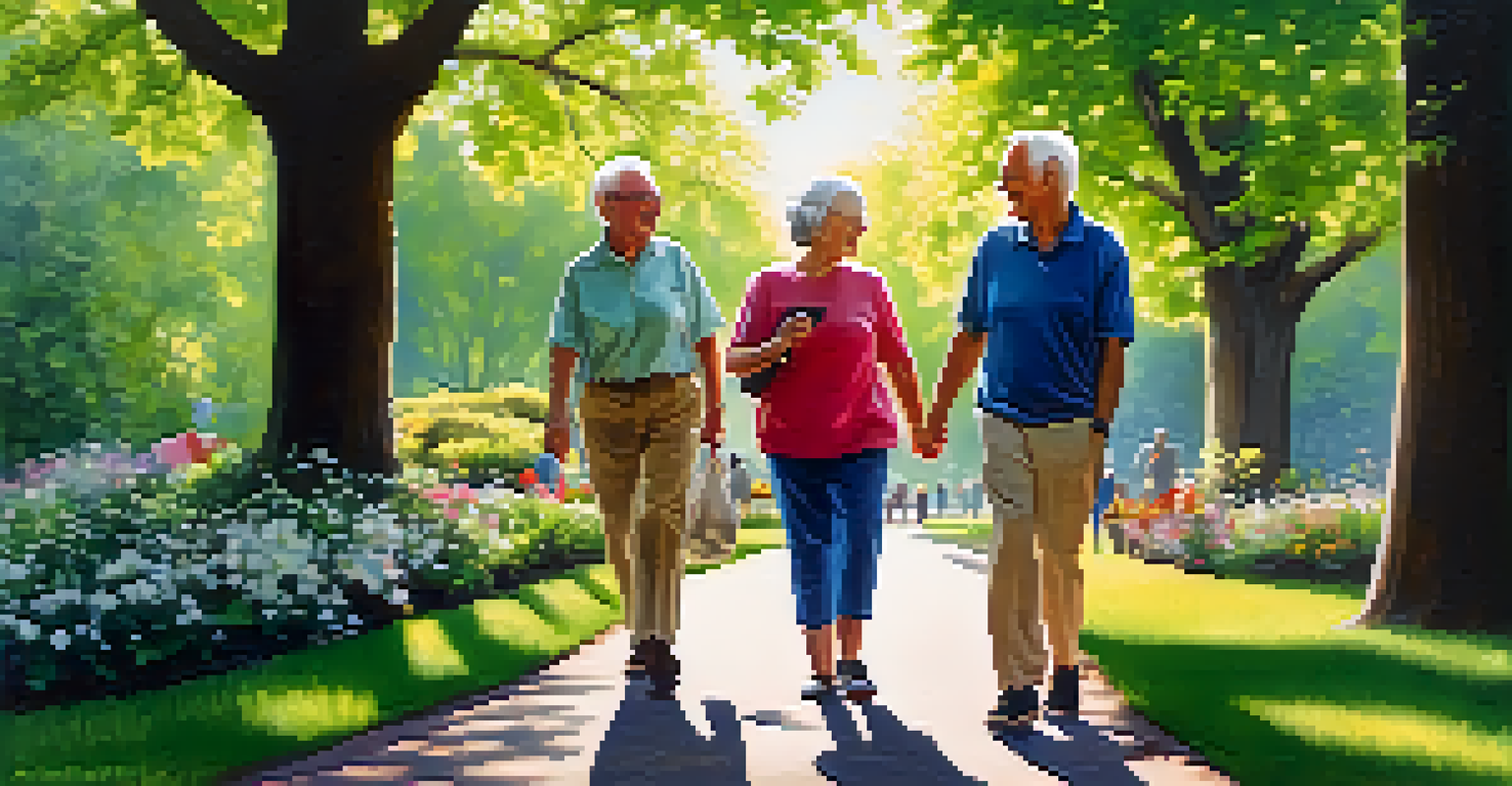Music as a Catalyst for Physical Activity in Seniors

The Connection Between Music and Movement in Seniors
Music has a unique ability to connect with our emotions, and for seniors, this connection can be particularly powerful. When familiar tunes play, they often evoke memories of joyful times, motivating seniors to get up and move. This relationship between music and movement isn't just anecdotal; studies show that rhythm can enhance physical activity levels.
Music can change the world because it can change people.
One of the most engaging aspects of music is its ability to inspire action. When seniors listen to lively music, they may feel compelled to dance or walk, turning what could be a mundane activity into an enjoyable experience. This transformation is vital since enjoyment plays a key role in sustaining physical activity over time.
Moreover, music can serve as a form of motivation, encouraging seniors to stick to their exercise routines. Whether it's a favorite song on a walk or a dance class set to upbeat tracks, the right music can provide the extra push needed to stay active.
How Music Can Enhance Exercise Routines
Incorporating music into exercise routines can significantly enhance the overall experience for seniors. Instead of viewing physical activity as a chore, they can associate it with fun, rhythm, and energy. For instance, a simple walk can feel like a dance party when paired with an upbeat playlist.

Additionally, specific genres of music can influence the pace and intensity of workouts. Fast-paced music can elevate heart rates and encourage more vigorous movements, while slower tunes can aid in cool-down routines. This tailored approach ensures that seniors can adapt their exercises to fit their energy levels and preferences.
Music Boosts Movement in Seniors
Familiar tunes can evoke joyful memories, motivating seniors to engage in physical activity.
Creating a personal playlist can also empower seniors to take charge of their fitness journey. By selecting songs that resonate with them, they can establish a routine that feels uniquely theirs, making it easier to stay committed.
Music Therapy: A Powerful Tool for Seniors
Music therapy has emerged as a valuable tool in enhancing the well-being of seniors. Certified music therapists use songs and musical activities to promote physical movement and emotional health. This therapeutic approach can help seniors engage in activities that improve their mood while also encouraging physical exercise.
Where words fail, music speaks.
In group settings, music therapy can foster social connections among seniors, making exercise a shared experience. For example, group singing or drumming sessions can lead to laughter and camaraderie, further motivating individuals to participate. This social aspect can make physical activity feel less isolating.
Furthermore, music therapy can be particularly beneficial for seniors with cognitive impairments, such as dementia. Familiar songs can stimulate memories and prompt movement, creating a holistic approach to both mental and physical health.
Creating the Perfect Playlist for Seniors
When it comes to encouraging physical activity through music, a well-curated playlist is essential. The key is to include songs that are not only enjoyable but also inspiring to move to. Think of songs from their youth or popular hits that evoke positive memories.
A great strategy is to mix genres and tempos to keep things interesting. Incorporating classic rock, pop, jazz, and even some upbeat classical music can create a varied listening experience. This diversity helps maintain engagement, as seniors may respond differently to different styles.
Personal Playlists Enhance Exercise
Creating tailored playlists allows seniors to enjoy their workout routines and stay committed.
It's also important to consider the tempo of the songs. Tracks with a steady beat can help seniors maintain a consistent pace during walks or workouts, while more energetic songs can encourage faster movements. Tailoring the playlist to their preferences ensures they look forward to their exercise sessions.
The Role of Music in Group Activities for Seniors
Group activities can be significantly enhanced by the incorporation of music, fostering a sense of community among seniors. Whether it's a dance class, a group exercise session, or even a sing-along, music brings people together and encourages participation. The shared experience of moving to a rhythm can create bonds that help reduce feelings of loneliness.
In many cases, group activities with music can be more effective than solo exercises. The energy and enthusiasm of a group can motivate individuals to push their limits and stay engaged longer. For instance, a group dance session not only provides physical benefits but also boosts morale and encourages social interaction.
Moreover, these group activities can be tailored to different fitness levels, ensuring everyone can participate. This inclusivity allows seniors to enjoy the benefits of physical activity while making new friends and having fun.
Music's Impact on Mood and Motivation to Move
The psychological benefits of music are well-documented, and for seniors, this can translate into increased motivation to engage in physical activity. Listening to uplifting music can elevate mood, making it easier to get moving. When seniors feel good, they are more likely to participate in exercise, whether it's a walk in the park or a dance class.
Additionally, music can serve as a powerful cue for physical activity. For example, hearing a specific song might remind a senior of a dance they enjoyed, prompting them to get up and move. This association can create a positive feedback loop, where music and movement reinforce each other.
Music Therapy Fosters Social Bonds
Group music activities promote social connections, making exercise feel more enjoyable and less isolating.
As a result, integrating music into daily routines can enhance not just physical activity levels but overall quality of life. A simple song can bring joy and motivation, making exercise feel less like a task and more like a celebration.
Practical Tips for Incorporating Music into Daily Life
Incorporating music into daily life doesn’t have to be complicated. Simple steps like playing music during household chores can make these tasks more enjoyable and encourage movement. For instance, putting on a favorite song while cleaning can turn a mundane chore into a mini dance party.
Seniors can also benefit from joining classes that integrate music with exercise, such as Zumba or line dancing. These classes not only provide structured physical activity but also create a fun atmosphere filled with music and social interaction. It's a win-win for both fitness and fun.

Lastly, setting aside time for daily music enjoyment can be an excellent way for seniors to unwind and stay active. Whether it’s listening to music while gardening or taking a leisurely stroll with headphones, these moments can seamlessly weave physical activity into a joyful routine.